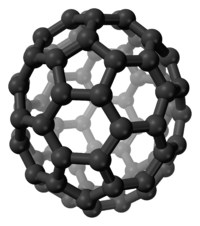C70 fullerene
 |
|
| Names | |
|---|---|
|
IUPAC name
(C70-D5h)[5,6]fullerene
|
|
| Other names
Fullerene-C70, rugbyballene
|
|
| Identifiers | |
|
115383-22-7 |
|
| 3D model (Jmol) | Interactive image |
| ChEBI | CHEBI:33195 |
| ChemSpider | 17288599 |
| ECHA InfoCard | 100.162.223 |
| PubChem | 16131935 |
|
|
|
|
| Properties | |
| C70 | |
| Molar mass | 840.77 g·mol−1 |
| Appearance | Dark needle-like crystals |
| Density | 1.7 g/cm3 |
| Melting point | sublimates at ~850 °C |
| insoluble in water | |
| Band gap | 1.77 eV |
|
Except where otherwise noted, data are given for materials in their standard state (at 25 °C [77 °F], 100 kPa).
|
|
|
|
|
| Infobox references | |
C70 fullerene is the fullerene molecule consisting of 70 carbon atoms. It is a cage-like fused-ring structure which resembles a rugby ball, made of 25 hexagons and 12 pentagons, with a carbon atom at the vertices of each polygon and a bond along each polygon edge. A related fullerene molecule, named buckminsterfullerene (C60 fullerene), consists of 60 carbon atoms.
It was first intentionally prepared in 1985 by Harold Kroto, James R. Heath, Sean O'Brien, Robert Curl and Richard Smalley at Rice University. Kroto, Curl and Smalley were awarded the 1996 Nobel Prize in Chemistry for their roles in the discovery of cage-like fullerenes. The name is a homage to Buckminster Fuller, whose geodesic domes these molecules resemble.
Theoretical predictions of buckyball molecules appeared in the late 1960s – early 1970s, but they went largely unnoticed. In the early 1970s, the chemistry of unsaturated carbon configurations was studied by a group at the University of Sussex, led by Harry Kroto and David Walton. In the 1980s a technique was developed by Richard Smalley and Bob Curl at Rice University, Texas to isolate these substances. They used laser vaporization of a suitable target to produce clusters of atoms. Kroto realized that by using a graphite target.
C70 was discovered in 1985 by Robert Curl, Harold Kroto and Richard Smalley. Using laser evaporation of graphite they found Cn clusters (for even n with n > 20) of which the most common were C60 and C70. For this discovery they were awarded the 1996 Nobel Prize in Chemistry. The discovery of buckyballs was serendipitous, as the scientists were aiming to produce carbon plasmas to replicate and characterize unidentified interstellar matter. Mass spectrometry analysis of the product indicated the formation of spheroidal carbon molecules.
...
Wikipedia
